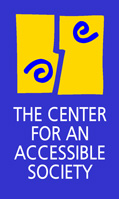
DISABILITY
ISSUES
INFORMATION
FOR JOURNALISTS
ABOUT
THE CENTER
Wed, 16 Apr 2003 -- Media Matters No. 28:
Structuring your report to interest the mediaThis is the third in our series of Media Matters devoted to gaining media attention for your research report. Thanks to the SPIN Project, from which much of this material was taken.
Our last Media Matters discussed "news hooks" to make reporters pick up and look at your report. Today's Media Matters looks at ways to keep them interested and reading -- by how you structure your contents.
It's important to remember that you're aiming for a entirely different audience than usual: not readers of a peer-reviewed journal, but reporters -- who, if they are interested in your report, will tell millions of people about your research.
THE COVER should have the title, a catchy subtitle (see Media Matters No. 27), names of author(s) and the report's sponsor or funding agency
THE TABLE OF CONTENTS should be clearly annotated for ease of reading and finding separate sections.
THE EXECUTIVE SUMMARY should read like a press release. It is the first thing reporters will read -- sometimes the only thing they will read. Use it to frame the issue, summarize the news, highlight your strategic key messages, present key findings and provide the most important facts. It must be concise, not longer than two or three pages. The key thing: the Executive Summary should conclude something. It can conclude anything you want it to conclude -- as long as you can back up the conclusion with your data and evidence. The conclusion is your frame, your message. If it isn't newsworthy (see Media Matters No.2), reporters probably won't pay attention to it.
THE OVERVIEW SECTION is the main body of the report. It typically contains an elaboration on the findings; more in-depth facts and analysis. It should also contain historical, legal and political context and a small "greatest hits" sampling of personal statements of people affected by the research or participants in the study.
THE METHODOLOGY SECTION provides all the logistical and statistical background on how you did the report and bolsters its factual integrity. Include this section in the Overview -- or right before it.
THE PROFILES SECTION -- personal testimonials or a listing of incidents/experiences of your research subjects -- often is the most dramatic section, as it highlights the impact of the research on real people. A report on affordable, accessible housing would include an "experiences" section -- with sub-heads like "Isolated," "Trapped," "Homeless"; these would be real-life stories from people needing accessible housing. This will put a human face on your report.
THE CONCLUSIONS/RECOMMENDATIONS section is the final section of the report. These were touched on SUMMARY section; here they are spelled out in detail. It's always useful to repeat, repeat, repeat!!
THE APPENDIX includes charts, tables, graphs, press clips and other information.
FINALLYÉ
PAY ATTENTION TO HOW IT LOOKS: Consider having your report designed and professionally produced for the media. Why spend all that time and money only to produce a tacky-looking document that poorly reflects the professionalism of your group, and will probably get tossed right into the trash? In addition to charts and other graphic items, photographs and illustrations can drive home the points made in your report.
In our next Media Matters: You must have a plan for disseminating your report through mass media. We'll discuss developing that.
Contact us at info@accessiblesociety.org